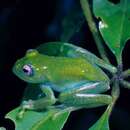Description
provided by AmphibiaWeb articles
A medium-sized green treefrog. Males 31-33 mm. Remark: This species is very similar to Boophis jaegeri in morphology. It differs in several details of the colouration, and the call, which sounds very different. Although call features as frequency range and note repetition rate are similar to B. jaegeri, we heard several choruses of B. jaegeri in different months at Nosy Be and we never heard there the long call series typical for B. andreonei. This makes it extremely unlikely that the long call series is only a different call type of B. jaegeri. Holotype: Adult male, ZFMK 57393, from Benavony (near Ambanja, NW-Madagascar). SVL 31 mm, head width 11.8 mm; eye diameter 4.1 mm, tympanum indistinct, horizontal diameter of tympanum about 1.9 mm; distance eye-nostril 2.0 mm, distance nostril-tip of snout 3.0 mm; hand length 9.2 mm, length of foot and tarsus 21.5 mm. Tibiotarsal articulation reaches the nostril when hind leg is brought forward. Tips of fingers and toes circularly enlarged. A distinct nuptial pad is present on the inner side of the first finger. The tibia is clearly longer than the foot. Vomerine teeth are present. Webbing of the hand 1(-), 2i(-), 2e(1), 3i(2), 3e(1), 4(0.75); webbing of the foot 1(0), 2i(0.5), 2e(0), 3i(0.75), 3e(0), 4i/e(1), 5(0). Skin on the back smooth. In life green dorsum, mottled with indistinct dark green spots. No trace of a dorsolateral stripe. Lower arm and tarsus with yellowish white fringes. Venter whitish, ventral surface of fingertips green. Throat and ventral surface of arms and legs greenish blue. In preservative ventral and dorsal surface uniformly yellowish white. Iris silvery grey surrounded by orange on the outer iris area; the whole iris irregularly reticulated with red. Posterior iris periphery light (not blue). Dorsally the eye periphery is blue. Paratypes: two adult males with nuptial pads (ZFMK 57391 and 57392, SVL 30.5 and 32.5, respectively) from same locality as holotype. Morphological features and colouration very similar to the holotype.Derivatio nominis: Dedicated to Franco Andreone, Torino, in recognition for his contributions to the knowledge of the Malagasy anuran fauna, especially of the Boophis luteus-group.Taken with permission from Glaw and Vences (2007).
Glaw, F. and Vences, M. (2008). Boophis andreonei. In: IUCN 2008. 2008 IUCN Red List of Threatened Species. www.iucnredlist.org. Downloaded on 08 April 2009.
- author
- Miguel Vences
- author
- Frank Glaw
Distribution and Habitat
provided by AmphibiaWeb articles
Benavony, Manongarivo, Tsaratanana (Antsahamanara campsite). It occurs between 200-700 m asl in pristine and slightly degraded forest close to primary forest (Glaw and Vences 2008).
- author
- Miguel Vences
- author
- Frank Glaw
Life History, Abundance, Activity, and Special Behaviors
provided by AmphibiaWeb articles
Calling males were found in March at night in choruses along a brook in primary forest. Males were sitting about 2-4 m above the ground in the vegetation. Call (from the terra typica): The call is a series of melodious notes (= pulses, see B. jaegeri), which can last for more than 10 s. Note duration is about 20 ms, intervals between notes last 25-30 ms. Note repetion rate is extremely high (about 21/s!, compare with B. jaegeri). Frequency is between 4 and 4.5 kHz.Breeding takes place in streams (Glaw and Vences 2008).Eggs and tadpoles: Unknown.
- author
- Miguel Vences
- author
- Frank Glaw
Life History, Abundance, Activity, and Special Behaviors
provided by AmphibiaWeb articles
Vulnerable: extent of occurrence is less than 20,000 km2, its distribution is severely fragmented, and there is continuing decline in the extent and quality of its habitat in northwestern Madagascar. It occurs in the Réserve Spéciale de Manongarivo (Glaw and Vences 2008).
- author
- Miguel Vences
- author
- Frank Glaw
Boophis andreonei: Brief Summary
provided by wikipedia EN
Boophis andreonei is a species of frog in the family Mantellidae. It is endemic to Madagascar. Its natural habitats are subtropical or tropical moist lowland forests and rivers. It is threatened by habitat loss.
- license
- cc-by-sa-3.0
- copyright
- Wikipedia authors and editors

